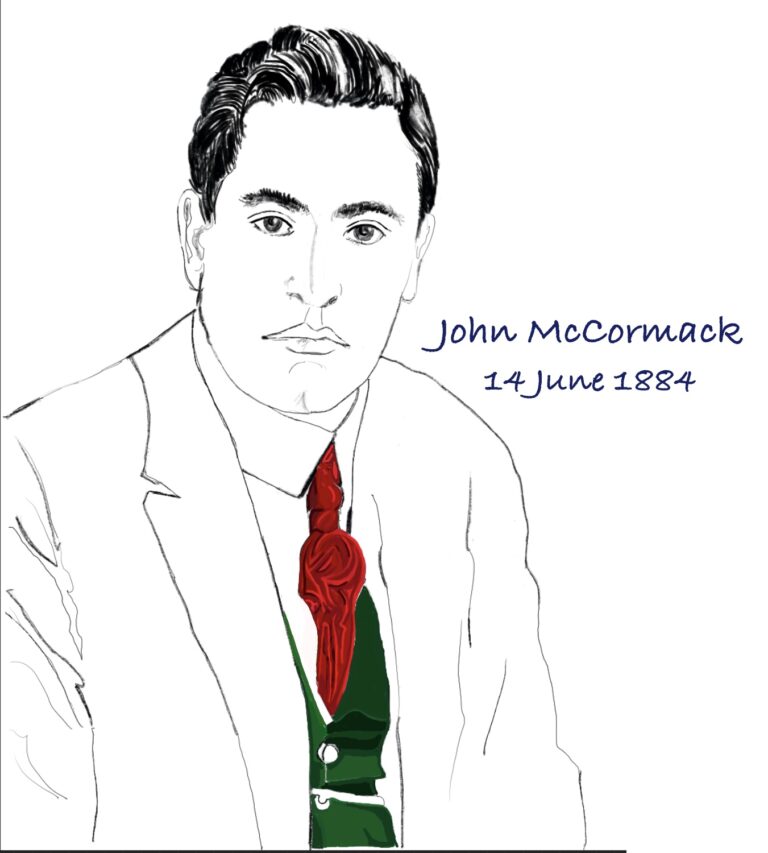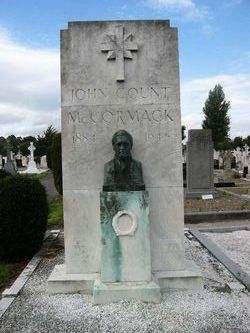JOHN MCCORMACK
TENOR
JUNE 14TH, 1884

Could any singer have ever received so many accolades, titles and fame in their lifetime? Maybe Beniamino Gigli did…
John McCormack’s life seemed charmed being interwoven with fame and fortune from its very beginning. Born in Westmeath, County Athlone in Ireland, his musical leanings were nurtured by singing in the church choir and no doubt also, by his Scottish parents who incidentally possessed fine singing voices.
Later when the family moved to Dublin he joined the St. Mary’s Pro Cathedral Choir. There his talent was recognised by the choir master and composer Vincent O’Brien.
One year after training he won the coveted medal Feis Ceoil for his singing (1). The following year he encouraged his friend, also a tenor who would later be famous in his own right, the author James Joyce, to enter the singing competition. Joyce, received 3rd place (2). One wonders what career path Joyce may have chosen had he won!
Fund raisers enabled him to train with Vincenzo Sabatini in Milan. Sabatini did not find his voice at all wanting and concentrated on teaching him a breathing technique which was to become a hallmark of McCormack’s singing. Famous for his extraordinary breath control, he could sing sixty four notes on one breath in Mozart’s “Il mio tesoro” from Don Giovanni, and his singing of pieces by Händel was just as impressive in this remarkable ability.
He made his operatic debut under the name of Giovanni Foli in Mascagni’s L’amico Fritz in 1906 (3). Engagements in America followed and at the height of his career he toured Australia as the star tenor for the Melba Grand Opera season of 1911. From 1908 to 1914 he performed regularly at Covent Garden with either Nellie Melba or Luisa Tetrazzini (4).
From 1912 his interest turned more and more in the direction of concert performances which brought his voice to the masses – and the masses adored him.
He became the Victor Talking Machine Company’s most popular ‘Red Seal’ recording artist after Enrico Caruso. Apropos Caruso, after hearing Caruso’s performance in the front row as Rodolfo in La Boheme at Covent Garden, McCormack said: “It was the best lesson, up to that moment, I had ever received and a stimulus which cannot be described. The sound of Caruso’s voice that night lingered in my ears for months” (5).
Or from another account, “as to this schooling he was prompted by hearing a Caruso at Covent Garden in 1904. McCormack was twenty then, and just beginning a career as a professional singer. ‘I will never rest’ he said to a friend after that performance.I will work and train and pray and someday there will be two men singing like that. Caruso and me” (6).
Two years later he was singing in London himself, becoming the Covent Garden’s youngest leading tenor in Mascagni’s Cavalleria Rusticana.
He continued to receive praise as his unstoppable star ascended. The famous violinist, Jan Kubelik, remarked in paying him one of the greatest compliments after hearing him in Prague: “that man must have a Stradivarius in his throat” (7).
Possibly because he didn’t quite enjoy the acting side of performing opera, or that he realised he could reach more people and make more money from his voice whilst performing with the likes of Fritz Kreisler, he decided to pursue concert performing and the popular music recording artist path. During the catastrophe of the First World War, in 1917, he also decided to become an American citizen. McCormack’s biographer, Gordon Ledbetter, believes the tenor was the last singer to successfully bring together such divergent styles (8).
Another biographer attempting to convey McCormack’s widespread fan base to contemporary audiences said he was like Pavarotti, Madonna and Johnny Carson all rolled into one! (9)
Certainly his wartime hits appealed greatly to the Irish population in America as they could show pride in both Ireland and the United States. McCormack became a radio megastar and donated to the U.S war effort and catholic charities generously (10).
Some of his hits at the time were ‘It’s a Long Way to Tipperary’ ‘Mother MacCree’ and for the Hollywood film ‘Song o’My Heart’ where he was paid half a million dollars to sing eleven songs for the soundtrack.
He became a very wealthy man and by all accounts enjoyed his wealth to the fullest, giving back to the public in the form of many benefit concerts and donations (11).
Not many opera singers are created Papal Counts – not so for John Count McCormack as seen engraved on his headstone where he is buried in his birth country of Ireland. Earlier in his life he had also received three Papal Knighthoods in addition to being a Knight of Malta. He died at the age of 61 of bronchial pneumonia seven years after giving his farewell performance at the Royal Albert Hall. Despite the farewell performance in 1938, during the Second World War, he came out of retirement in support of the Red Cross. Quite a life!

(13)
FOOTNOTES
(1) FEIS CEOIL
(3) SHAWE-TAYLOR, DESMOND., in THE GROVE BOOK of OPERA SINGERS, ATICLR MCCORMACK, JOHN., P.292
(4) Ibid.
(5) HISTORY OF THE TENOR. JOHN MCCORMACK-OPERATIC TENOR
(7) Ibid.
(8) LEDBETTER, GORDON., THE GREAT IRISH TENOR, TOWN HOUSE, 2003
(9) IRISH AMERICAN MAGAZINE, DEC/JANUARY 2009, THE ORIGINAL IRISH TENOR: JOHN MCCORMACK
(10) Ibid.
(11) Ibid.
(12)COLIN LARKIN, ED. (1992), THE GUINNESS ENCYCLOPEDIA OF POPULQR MUSIC (FIRST EDITION), GUINESS PUBLISHING, P. 1554.